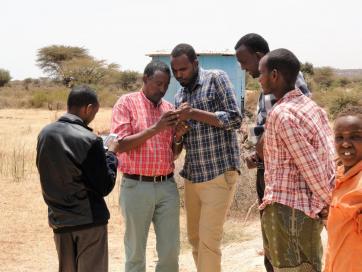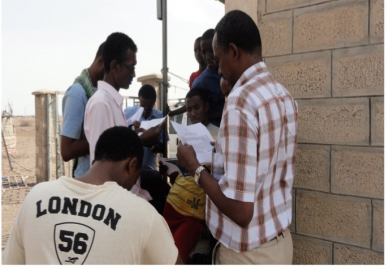The capacity to use WaSH Monitoring and Evaluation (M&E) Management Information System (MIS) at lower levels for planning, reporting and learning looks frail.
Published on: 22/08/2016
Some five months ago, I observed the distribution of equipment and furniture by the Ethiopian Ministry of Water, Irrigation and Electricity to all regions to get the national computer-based monitoring system for water, sanitation and hygiene (WaSH) running. The government has invested considerable resources in this effort. Training for all regions has also been provided in 2014 and 2016.
 Recently, while visiting regions and woredas, I had the chance to observe how the roll out of WaSH M&E MIS (Water, Sanitation and Hygiene Monitoring and Evaluation Management Information System) is going. At regional level, there are efforts to use the WaSH M&E MIS for planning, water coverage calculations and reporting on non-functionality rates. The Afar region Water Project Management Unit M&E specialist said that National WaSH Inventory data was collected [in 2010] and the MIS has been already developed, but the data is not being updated and the MIS is not used. This is happening for different reasons: the failure of the training provided for the regional and woreda staffs to create adequate knowledge and skills to use the system, various errors on using the system and a lack user friendliness of the software. Thus, to date the regional bureau in Afar has not managed to use the system to update and use data for planning, reporting and learning. This situation clearly shows the challenges in getting the new IT system used at regional, zonal and woreda level.
Recently, while visiting regions and woredas, I had the chance to observe how the roll out of WaSH M&E MIS (Water, Sanitation and Hygiene Monitoring and Evaluation Management Information System) is going. At regional level, there are efforts to use the WaSH M&E MIS for planning, water coverage calculations and reporting on non-functionality rates. The Afar region Water Project Management Unit M&E specialist said that National WaSH Inventory data was collected [in 2010] and the MIS has been already developed, but the data is not being updated and the MIS is not used. This is happening for different reasons: the failure of the training provided for the regional and woreda staffs to create adequate knowledge and skills to use the system, various errors on using the system and a lack user friendliness of the software. Thus, to date the regional bureau in Afar has not managed to use the system to update and use data for planning, reporting and learning. This situation clearly shows the challenges in getting the new IT system used at regional, zonal and woreda level. 
In Mile, a rural woreda in Afar, the Woreda Water Office Water Supply and Irrigation Core Process Owner told me that he was selected from his woreda and received the training to use the system. This was organized and rolled out by the Ministry of Water Irrigation and Energy (MoWIE). He said, "I have got ... skills to use the WaSH M&E MIS. However, I don't have enough time to sit at the computer and work on it since I have a lot of other assignments. In addition, there is no WASH M&E MIS system in place, both hardware and software". The expert who is directly working on water supply, however, had no idea about the WaSH M&E MIS nor had he taken the training. The WaSH expert said, "There are a lot of training opportunities that exist and provided by the MoWIE, Regional Water Resource bureau and other development partners. The problem is that appropriate experts do not get to receive such kinds of training". He further said, "As a part time job, I have a small computer centre and am providing IT support for clients in the town. Had I received the WaSH M&E MIS training at least once, I would have been able to use the system as much as possible."
MoWIE is working hard to roll out the WaSH M&E MIS system. In 2015 and 2016 the Ministry procured more than 900 desktop and laptop computers with full accessories (UPS, Internet cables, etc), servers and furniture (chairs and tables), which were distributed to all the regions and city administrations. At the time of my visit to Afar and Somali, this equipment and furniture was still stored in the regional Water Bureaus. The Woreda Water Offices are unsure on when they will receive the materials.
At the woreda levels, where most of the work on WASH services is done, there remains a chronic gap in capacity, both human and physical. It is going to take a big effort, but we need to build capacities at the woreda levels to get the system used for monitoring, reporting, and planning. The Lowland WASH activity funded by USAID is aiming to support this as one of its activities and we will do our best to support in Afar and other regions.
At IRC we have strong opinions and we value honest and frank discussion, so you won't be surprised to hear that not all the opinions on this site represent our official policy.